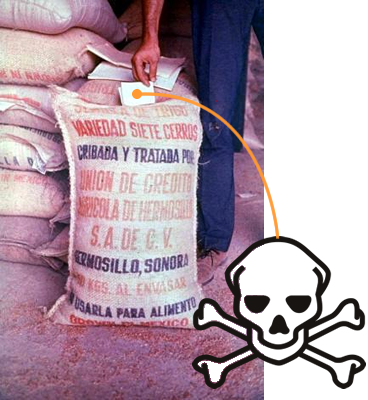Understanding that a label with a skull and crossbones represents danger is not entirely universal. Misunderstanding it, in fact, caused one of the biggest mass poisonings in history. This disaster occurred in 1971, before the Iraq war, in Kirkuk, a province north of Baghdad. Patients from local farming communities came into hospitals with exceptionally serious conditions:
- sensory and motor loss
- numb hands and erratic speech
- hearing loss, affected vision, and blindness
- coma, near-death
It was soon determined that the Iraqis were victims of poison, caused by eating a critical crop: grain.
- Rice with methyl mercury (original image via Wikipedia)
Due to droughts over a couple of years, grain supplies were scarce. Farmers began to use seed grain, normally used for only planting, for eating. Shipments of emergency rations were sent, but delayed. The Iraqi Ministry of Health ordered these grains to be dyed with methyl mercury fungicide, which is applied to seed grain to prevent it from spoiling. However, adding the fungicide to the grain made it unsuitable for consumption. It was only safe for planting, and it had been dyed red as a warning of its toxicity. In each sack, a label was sewn into the seam that had an English warning that the grain could not be consumed or milled into flour. Above the text, there was a skull and crossbones picture to reinforce the hazard.
A skull and crossbones icon is typically the universal symbol for indicating poison, but the Iraqi farmers receiving the grain did not understand the symbol or the foreign words below. To them, the skull and crossbones graphic was merely a strange piece of art, so they did not think that it represented death, danger, or hazardous materials. The red color did not dissuade the communities, either. The farmers washed the dye in large bowls to get rid of the red dye.
Water could not strip the grain of its toxic methyl mercury, however. Without color and a recognizable symbol, it was impossible for the Iraqis to understand that the grain was poisonous. The grain was later milled into flour, largely used for bread food products. Symptoms took about a couple of months to emerge, since organic mercury leaves the body very slowly, wreaking damage on the nervous system.
Now known as “the Iraq poison grain disaster,” the final toll was 6, 530 hospital admissions and 459 deaths, which were all entirely preventable. How? The traders dispensing the rice bags arguably could have communicated the hazards more clearly or at least have written them in the local language, Arabic. The skull and crossbones sign is now widely used by OSHA (America’s Occupational Safety and Health Administration) as the universal symbol for poison. The message is most powerful when reinforced with comprehensible language that emphasizes that danger is ahead, making the skull and crossbones a warning signal, not decorative artwork.
Clearly, as the red rice case shows, hazardous chemicals can come in the most innocuous forms. When powerful chemicals are present, it is important to establish a careful management standard right away and ensure that others are clearly aware of hazards.
*Note: Most of the information for this post was taken from the story, “Silent Warning,” through the book “Set Phasers on Stun.” Images can be found from the site: http://corrosion-doctors.org/Elements-Toxic/Mercury-Iraq-1.htm
